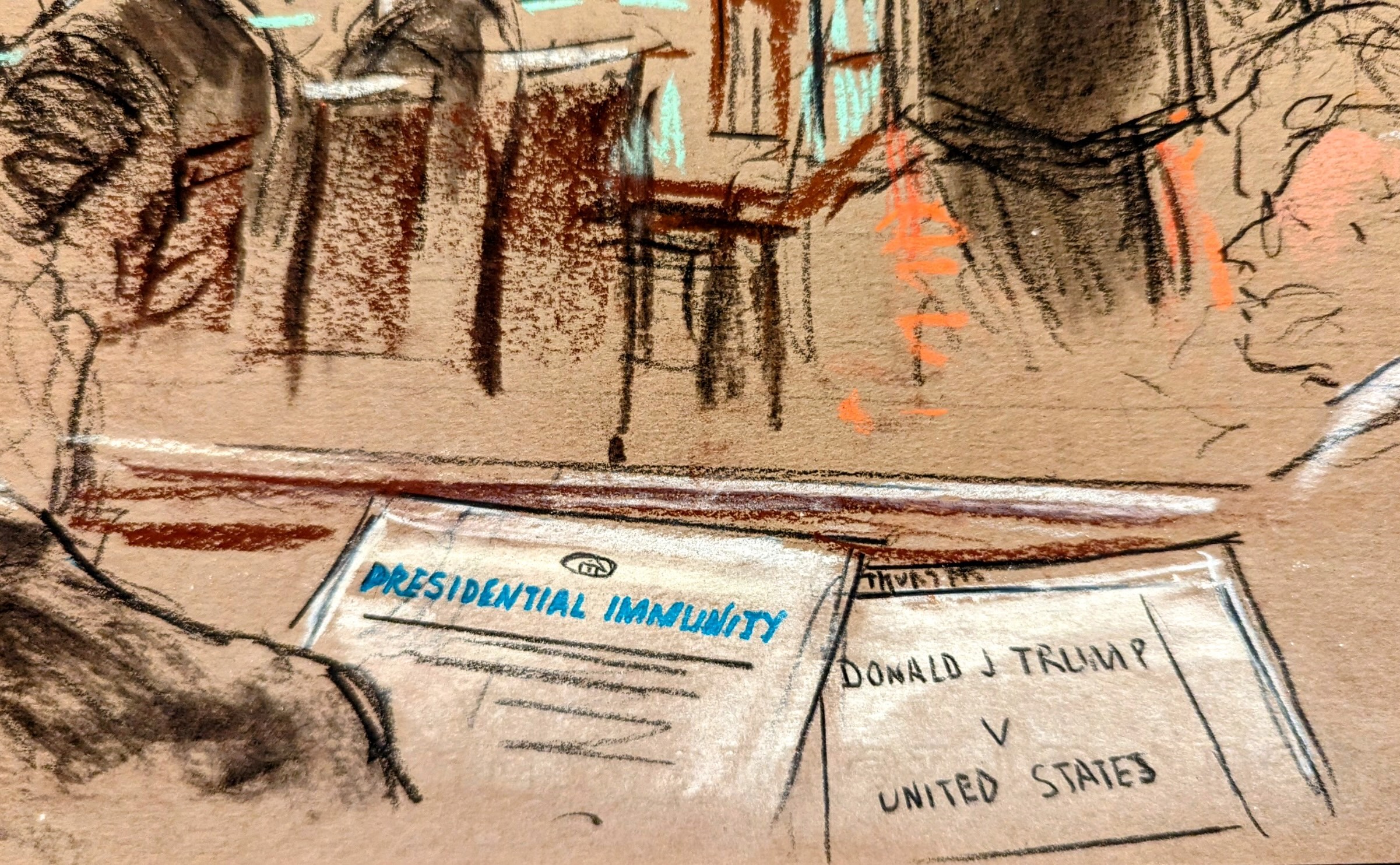VIEW FROM THE COURT
On presidential immunity, a riveting national civics lesson

on Apr 25, 2024 at 6:16 pm

Today is the last day of argument for the 2023-24 term, and – as everyone in the courtroom knows – we are here to see what is probably the biggest case of the term: Trump v. United States.
Yesterday, after an intense argument over abortion and emergency care in Moyle v. United States, Chief Justice John Roberts popped over to Georgetown University Law Center’s annual end-of-arguments reception, which revolves around the law school’s Supreme Court Institute and all those who participate in its moot courts preparing advocates who will argue their cases before the justices.
Roberts gave a tribute to the Supreme Court Institute itself, which is celebrating its 25th anniversary, and which he had participated in years ago as both an advocate preparing for argument and as a moot jurist helping others prepare.
“For a quarter of a century, the institute has brought together the very best of the appellate bar to prepare lawyers for appearances before our court,” said Roberts, who was joined at the event by Justices Elena Kagan and Brett Kavanaugh.
The chief justice also discussed how oral argument has changed recently, especially after the post-pandemic return to the bench and the addition of a “seriatim” round of questioning in seniority order, after the traditional “free for all” round. Roberts recalled with fondness one of his arguments as an advocate, in 1999’s Rice v. Cayetano.
“To give you an idea of how precisely the [then-Chief Justice William Rehnquist] ran things,” Roberts said, the audio recording for that argument “lasts exactly one hour, one minute and 11 seconds, time that included calling the case, three advocates making their way to the lectern, and adjourning the court for the day.”
Roberts was implicitly recognizing that the recent changes have led to some pretty lengthy argument sessions. The justices have made some progress this term keeping things in check. One case last week clocked in at 44 minutes (including calling the case, etc.). But the biggest cases can run for two hours or more.
Today, it will be “or more.”
The courtroom is filling up, though we know that the petitioner, former President Donald Trump, is otherwise occupied in a Manhattan courtroom, where the judge denied his request to be allowed to attend the Supreme Court argument in his federal case. (It’s debatable whether Trump was actually going to attend, or as with his Colorado ballot argument in February, his lawyers might have talked him out of showing up.)
For the record, the temperature in the courtroom is quite comfortable and not at all too cold, as the former president complained about his Manhattan courtroom last week.
In the bar section, Neal Katyal, a former acting U.S. solicitor general under President Barack Obama is here, as is Seth Waxman, a former solicitor general under President Bill Clinton. (Ted Olson, a solicitor general under President George W. Bush, was here Monday for the big argument in City of Grants Pass v. Johnson. Olson happened to win over Roberts in Rice v. Cayetano.)
In the public gallery, there are some spectators with no apparent connection to the case, but they seem to be happy to be here for this big argument. Former U.S. Sen. Doug Jones of Alabama, who was Justice Ketanji Brown Jackson’s “sherpa” during her confirmation, is seated in the back of the public gallery. In the front row, Judge Thomas Hardiman of the U.S. Court of Appeals for the 3rd Circuit, is here. Hardiman was twice a finalist for Supreme Court openings under Trump, and he famously set off speculation when he was spotted gassing up his car in Pennsylvania for a presumptive trip to Washington in 2017.
In the justices’ guest box, Jane Roberts and Ashley Kavanaugh, who both tend to come for some of the court’s biggest arguments, are here today.
At 9:45 a.m., Special Counsel Jack Smith, who brought the indictment against Trump over the former president’s alleged role in conspiring to overturn the results of the 2020 election, enters the courtroom and joins his team.
Smith is leaving the argument to his “counselor to the special counsel,” Michael Dreeben, a veteran of the solicitor general’s office who has argued more than 100 cases in the high court. Dreeben is wearing an ordinary business suit, and not the morning coat usually worn by male lawyers for the federal government, though later, in questioning, he will tell the justices, “I am speaking on behalf of the Justice Department. We’re representing the United States.”
At the petitioner’s counsel’s table is John Sauer of the James Otis Law Group of St. Louis, who will argue on behalf of the former president. Sauer was a law clerk to Justice Antonin Scalia and served as solicitor general of Missouri.
When the justices take the bench at 10 a.m., Roberts immediately calls the case. There are no opinions or bar admissions as preliminaries. What follows is a 2-hour, 40-minute high-minded civics lesson. It’s a bit of a shame that there do not appear to be any classes of high school students in the courtroom today, as there were earlier this week.
There are references to Supreme Court foundational classics such as Marbury v. Madison and McCullough v. Maryland, as well as to United States v. Nixon (the Watergate tapes case), Nixon v. Fitzgerald (which held that the former president had absolute immunity from civil liability for his official acts in office), and Morrison v. Olson, about the then-in-force independent counsel law. Sauer refers to Founding Fathers including James Madison and Gouverneur Morris. (I need to dig up the 8th-grade civics paper I did on the Pennsylvania delegate to the Constitutional Convention, and see whether I covered Morris’s point about “co-agitators.”)
There are questions about other U.S. presidents who might have been prosecuted for official acts. Justice Clarence Thomas refers to Operation Mongoose, involving CIA and other U.S.-led efforts under President John F. Kennedy to interfere in Cuba. Justice Samuel Alito asks about President Franklin D. Roosevelt’s internment of Japanese and Japanese-American citizens during World War II. Kavanaugh raises President Lyndon B. Johnson’s false statements regarding the Vietnam War.
Kavanaugh asks about President Gerald Ford’s pardon of President Richard Nixon soon after Nixon resigned in 1974.
“Very controversial in the moment,” Kavanaugh says. “Now looked upon as one of the better decisions in presidential history, I think, by most people. If he’s thinking about, well, if I grant this pardon to Richard Nixon, could I be investigated myself for obstruction of justice on the theory that I’m interfering with the investigation of Richard Nixon?”
Some justices have no hesitancy to delve into the details of the allegations against Trump. Kagan presses Sauer with one of her lightning rounds of questions, about whether particular allegations involving the then-president’s communications with officials in Georgia and Arizona to change vote totals or investigate election fraud, and whether those acts were official or unofficial.
Justice Sonia Sotomayor later leads Dreeben down a philosophical path, telling him, “A stable democratic society needs the good faith of its public officials, correct? … And that good faith assumes that they will follow the law?”
But other justices repeatedly seek to keep the discussion away from the allegations in Trump’s case and focus on the implications of any ruling for future presidents.
“We’re writing a rule for the ages,” Justice Neil Gorsuch says.
The justices spend more time questioning Dreeben than Sauer, with Dreeben’s seriatim round alone running about an hour (the longest such round I can recall).
When that round finally ends, Roberts calls Sauer back for his rebuttal. The Trump lawyer, in a show of confidence that may either be savvy or a miscalculation, says, “I have nothing further, Your Honor.”
And with that, the civics lesson is over for today, with the updated curriculum expected by late June.


